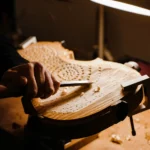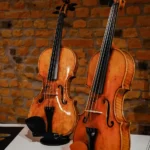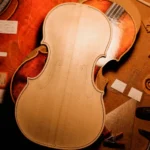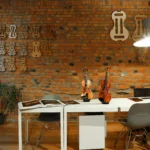Violin and Viola Bows Near Me: Quality Bows for Sale
Back to BlogViolin and Viola Bows Near Me: Quality Bows for Sale
Are you looking for a violin or viola bow? This comprehensive guide will explore the best ways to find a bow near you. Buying a violin or viola bow isn’t just about finding the piece for your instrument; it’s about making informed decisions that can impact your musical journey and finances.
So, whether you’re a seasoned musician looking to upgrade your bow, a student who has a bow that is no longer the right fit, or a collector seeking the next addition to the collection, this guide will give you the best strategies for finding the perfect bow while shopping.
Types of Violin and Viola Bows
When searching for the perfect bow, you must first of all identify what kind of bow you are looking for. Here are the main different types of bows:
– Carbon fiber bows: Made with carbon filaments and plastic polymer resin, carbon fiber bows are durable yet flexible. They are affordable and handle well under extreme temperatures.
– Pernambuco bows: Made from the heartwood of the Pau Brasil tree, native to Brazil, these are often deemed the best quality of bows. They are strong, flexible, and more responsive to the vibrations of the violin and viola, giving them richer sounds and performances when playing your instrument. The Pau Brasil tree has become endangered in recent years, making it unsustainable to harvest. This has raised the cost of existing bows and created wariness in musicians, as many newer bows are made from illegally harvested trees. This is why it is important to research a manufacturer before purchasing to ensure the bow is made sustainably.
How the type of bow can impact a musician’s performance.
Choosing the right kind of bow is important, as owning a good bow is just as important as owning a good violin or viola. A bow can bring out the best in your instrument, adding nuances to your performance; it will emphasize the overtones in the sound and can get out an extra 30 to 40% of your violin or viola’s voice. Wooden bows will help you bring out the best of your instrument’s voice. This is why it is better to invest more and have a better quality bow that enables you to play beautifully, rather than holding back on expenses but then not being able to bring out your best potential and having to upgrade again soon.
Start by searching for online shop and workshop options and looking for any ads for people who may be selling their bows on the Internet. Remember to ensure that the places you find online are trustworthy; research them and check their reviews before seeing the bow. If you find an ad of a person selling their bow, remember to ask for all necessary certifications before buying it and get an appraisal if needed.
What to look for when choosing a violin or viola bow, including bow weight, balance, and condition.
Balance of the violin bow
The balance of the bow is crucial as it affects your playing technique. A well-balanced bow will feel comfortable in your hand and allow you to produce a consistent sound across all strings.
If the balance point is closer to the frog, the bow will feel lighter, but you probably will have to pronate your wrist with more intensity to produce extra volume or tone, as the tip will lack weight on itself to allow stronger contact between the bow hair and the string. On the other hand, if the balance point is too close to the tip, the bow will feel too heavy and difficult to control. It can make it slower, as you must keep adding energy to continue the sequences of faster movement techniques in all bow regions. A tip that is too light might jump off too much, and an excessively heavier one wouldn’t match the necessary elasticity to allow movement.
Lighter, faster bows may match up with classic-period repertoire that will require most of the techniques of the French school, such as spiccato, sautillè, and martelè. Heavier tip bows might be more suitable for late romantic or modern pieces, in which the musician is more constantly requested to connect for longer into the strings.
Strength of the violin bow
Stiffer bows have a faster response but may only produce a shallower sound, limiting your ability to have a wider tone from your instrument. If the stick is too soft, it won’t allow the musician to apply all the required arm weight in the bow to connect with the strings and secure that grip properly, as it won’t offer enough resistance. A more flexible bow can help create rich tones but may have a lower response time. With the bow tightened adequately, the bow’s stick should not touch the strings when playing moderately loud.
Weight of the bow: the violin bow
The weight of the bow can also affect your playing technique. A lighter bow may be easier to maneuver, but it may not produce the fullest sound from your instrument. Although a lighter bow will feel easier to control, it should have the perfect balance between strength and flexibility to perform well.
On the other hand, a heavier bow may produce a richer sound but be harder to control.
Flexibility of the violin bow
The bow’s flexibility determines how easily it bounces off the strings. A more flexible bow may produce a more expressive and nuanced sound but may also be harder to control. A less flexible bow may produce a more direct and focused sound but may not allow for as much expression.
Condition and certification of the violin bow
When buying a used bow, always carefully check its general condition. This includes asking for its relative condition report and certifications, getting an appraisal, and testing it out well before completing the purchase.
Sound production of the violin bow
Ultimately, the most important factor to consider is the sound that the bow produces. A good bow should allow you to produce a clear and resonant sound across all strings and bring out the best of your instrument.
Assessing the bow’s playability and suitability for different skill levels.
With these things in mind, there are some tips that you can follow to properly assess the bows playability and suitability for you.
- Start by warming up with your current bow. Play a few scales and exercises with your current bow and concentrate on how it feels in your hand and what kind of sound it makes your instrument produce.
- Next, pick up the new bow and see how it feels. Check its balance by balancing it on your index finger and see if it feels comfortable in your hand. Try different hand positions and angles and see how they affect the bow’s balance.
- Play some scales on the new bow to test its flexibility. Try different techniques such as legato, spiccato, and staccato and see how the bow responds. Pay attention to the sound it produces.
- Play some arpeggios to test the bow’s bounce. Listen to how the bow produces the sound and whether it allows you to produce a consistent sound across all the strings.
- Play a few pieces on the new bow to evaluate its sound production. Try different styles of music to see how the bow responds to different techniques and sound dynamics.
- Repeat this whole process with different bows and take notes on how each bow sounds and feels to help you make an informed decision.
The trade-offs between affordable and professional-grade bows.
The main difference between affordable and professional-grade bows, apart from the cost, is the sound quality they will allow you to produce when playing your instrument. This is why, for a student or beginner, an affordable bow will suffice, even though the quality of it is not excellent; since the player is just starting out, it doesn’t matter if the bow doesn’t make their instrument sound its best. However, for professional or expert players, a higher quality bow will definitely help bring out the best of their instrument. Therefore, it is better to invest more but have a bow that will last longer and produce better music.
Testing out a potential new bow will allow you to evaluate some of the main factors that need to be considered, which are weight, balance and flexibility. It will allow you to see how the bow feels in your hand, how it plays on your instrument and compare it to your current bow. Since the bow should be an extension of your hand, with which you breathe life into the violin or viola, the connection of the bow with your hand should feel as natural as possible – the bow should become a part of your body and not be like a separate object.
The bow shouldn’t seem too light or heavy in your hand. It shouldn’t be too weak or soft: It shouldn’t collapse easily on the hair when playing, or flex too much laterally. We suggest playing a passage near the frog, in the middle, and near the tip. You should be able to play comfortably with all parts of the bow. When playing, listen to the sound each potential new bow produces and feel how the bow handles it. You should be able to notice differences in clarity, fullness of sound and surface noise and be able to tell if the bow enhances or detracts from your instrument.
Maintaining and Caring for Bows
Tips on bow maintenance and care to extend their lifespan.
The bow is just as important as the instrument itself. Without it, you wouldn’t be able to play your violin or viola. This is why it is important to keep it in optimal condition in order to extend its lifespan. Here are some tips for taking care of your new bow:
- When your bow is new or has new hair, apply rosin to the full length of the hair before you use it to play your instrument.
- Never touch the bow hair with your fingers.
- Loosen the bow hair after each time you play and before you return it to its case. This will prolong the life of the hair and prevent the stick of the bow from warping.
Some common issues and repairs that may be needed for your bow are:
- When playing your instrument, a strand of the hair may occasionally fray and break. When this happens, clip off the strand near the frog and the tip making sure not to clip off the other strands in the process.
- After a while, your bow’s hair will wear out. When this happens, take your bow to a luthier to have it checked.
- Any kind of splitting, cracking, loosening, etc. to the stick, frog, button or tip should be referred to a professional immediately.
A good bow should be like an extension of your hand. It should feel comfortable when you play and should bring out the best in your music. Consider this when searching for a new bow: it is extremely important to try it out and make sure it feels right in your hand.
Just like with your violin or viola, sometimes your bow may be holding you back from improving your skills or may not match your current instrument. Many musicians do not realize they need a new bow until they see an improvement after trying out a new one. When searching for the perfect bow, ask for help and consultation from teachers and professionals. If you are in Cremona, definitely come check out our fine selection of bows for sale here at Amorim Fine Violins; we are always available for advice regarding your bow and instrument, so do not hesitate to stop by. Or get to know our Free Home Trial service and Worldwide Shipping with a 30-day trial.
In any case, we would be happy to help you find your next violin or viola bow.









